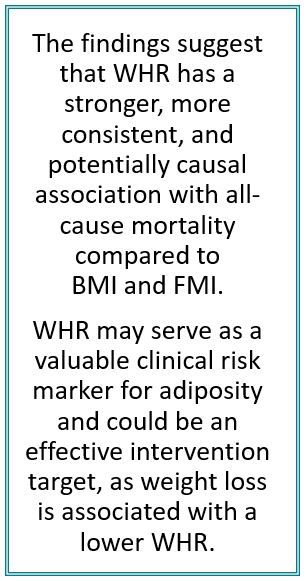- Clinical Technology
- Adult Immunization
- Hepatology
- Pediatric Immunization
- Screening
- Psychiatry
- Allergy
- Women's Health
- Cardiology
- Pediatrics
- Dermatology
- Endocrinology
- Pain Management
- Gastroenterology
- Infectious Disease
- Obesity Medicine
- Rheumatology
- Nephrology
- Neurology
- Pulmonology
Waist-to-Hip Ratio More Consistently Associated with Mortality vs BMI: New Research
Waist-to-hip ratio was more powerfully and consistently associated with risk of all-cause mortality than BMI or FMI, but can it replace BMI as a clinical indicator?
Wait-to-hip ratio (WHR) had a stronger and more consistent association with all-cause and cause-specific mortality than either body mass index (BMI) or fat mass index (FMI), regardless of BMI, according to a study of more than 387 000 individuals, suggesting that a focus on distribution vs mass of adiposity may be a more useful approach for clinical intervention.
©PhotoSG/stock.adobe.com

BMI is an easily calculated surrogate for adiposity, study authors wrote in JAMA Network Open Diabetes and Endocrinology, and while it has become a controversial screening tool, current recommendations for managing obesity rely almost exclusively on the measure as an indicator. Distribution of adipose tissue and body composition, however, is highly variable among individuals with the same BMI, they said. Further, while previous literature supports a J-shaped association between BMI and all-cause mortality, more recent research suggests a more complex relationship influenced by factors such as secular trends, ethnicity, and population. There are also observational data showing that both FMI and WHR are superior to traditional BMI in relation to disease and risk of mortality.
The investigators, led by Irfan Khan, MSc, of the Population Health Research Institute, David Braley Cardiac, Vascular and Stroke Research Institute, Hamilton, Ontario, Canada, suggest that an optimal clinical measure of adiposity would "have a strong causal relationship with adverse outcomes, have consistency across the range of body composition, and be easy to measure." It would also simplify identification of adiposity targets linked to the lowest risk of mortality.
Their study, accordingly, was designed to compare the 3 anthropometric adiposity measures (BMI, FMI, and WHR) with mortality from all-cause and specific causes, using both observational and Mendelian randomization (MR) analyses.
Study methods, population
To create the study cohort, the Canadian-led research team tapped the UK Biobank data set issued on August 3, 2021, comprised of 408 160 individuals who had appropriate genotypic data for analysis. After exclusions, the final cohort numbered 387 672; this group was divided to create a discovery cohort (n = 337 078) and a validation cohort (n = 50 594) to facilitate derivation polygenic risk scores used to assess predisposition to the 3 measures. Outcomes of primary interest to the researchers were all-cause, cancer-related, cardiovascular disease (CVD)–related, and respiratory disease–related mortality, along with mortality resulting from all other diseases (other).
The exposure-outcome associations were analyzed using Cox proportional hazard models and MR. Nonlinear MR was also conducted to assess the consistency of adiposity-mortality associations across different body composition levels.
FINDINGS

The 387 672-participant cohort had a mean age of approximately 59.3 years and was approximately 47.4% women, according to the study. Khan and colleagues reported a J-shaped association for both BMI and FMI with all-cause mortality. The association between WHR and death from any cause, however, was linear. The study found, in a departure from previous research, that genetically determined WHR had a stronger association with all-cause mortality and was more robust in men. In contrast to BMI or FMI, the genetically determined WHR–all-cause mortality association was consistent across quantiles of observed BMI.
The team's observational analyses yielded positive associations for all 3 adiposity measures with death related to cancer and CVD mortality; for both FMI and BMI, they found a J-shaped association with death from respiratory disease and "other" specific causes.
The findings, the team wrote, suggest that WHR has a stronger, more consistent, and potentially causal association with all-cause mortality compared to BMI and FMI. Moreover, WHR may serve as a valuable clinical risk marker for adiposity and could be an effective intervention target, as weight loss is associated with a lower WHR, they added.
Among the study’s limitations the authors note the genetically homogenous population, limiting generalization of the findings to other populations. Missing from the analyses were measures of changes in adiposity over time, which may have impacted mortality, they point out; and the definition of an optimal adiposity marker may have been incomplete.
In their conclusion, Kahn et al emphasize the inaccuracy of current recommendations for optimal BMI range given high individual variability in body composition. They call for additional research on the suitability of WHR vs BMI as the primary clinical measure of adiposity to help improve long-term health outcomes.
Source: Kahn I, Chong M, Le A, et al. Surrogate adiposity markers . JAMA Netw Open Diabetes Endocrinol. 2023;6(9):e2334836. doi:10.1001/jamanetworkopen.2023.34836
Obesity Linked to Faster Alzheimer Disease Progression in Longitudinal Blood Biomarker Analysis
December 2nd 2025Biomarker trajectories over 5 years in study participants with AD show steeper rises in pTau217, NfL, and amyloid burden among those with obesity, highlighting risk factor relevance.
